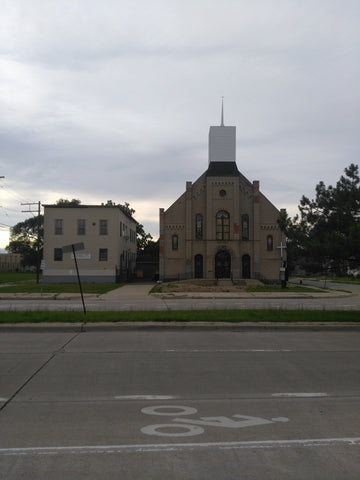“Great tree house,” I said as I slowed the car to the curb.
“It’s fun,” Marshall chirped.
The tree house, or perhaps more accurately described as an elevated fort, stood guard over the front yard of a tie-died painted flower facade and chiropractic practice. The yard was planted with concrete slab and native grasses, and a comforting weeping willow.
Marshall spoke to a group chilling below the fort’s slide. He knew one of the gentleman from an early sojourn in the neighbor. They spoke for a moment regarding the whereabouts of various fellow residents from his time there.
Inside was a vegan café currently patronized by an early-twenty-something couple, and an herb shop selling a multitude of remedies stored in glass jars. We spoke to the guy behind the herb counter, Marshall again asking who was about and who had moved to their next stop.
Back outside, we continued into the neighborhood on foot, our backs to Woodward.
I had listened to NPR podcasts about the burned-out houses, but to witness these scarred husks of homes in person was a different matter.

A typical building in Detroit Metro Area
Many houses still stood, their red brick walls and forged iron facades standing stoic and alone. They reeked, but the bones seemed sounds. I asked Marshall about how much one of these beauties would cost, a fantasy of buying and revitalizing flashing through my mind.
“You can’t buy these. The Landbank owns them.”
“And what will they do with them?”
“Knock’em down,” Marshall sighed as he kicked at a piece of asphalt shyly.
“But their beautiful… why?” Avantika asked, shocked.
“They’ve been gutted for copper pipping. I know what you mean. They look good from the outside, but to actually make one livable? Cheaper and easier to just level it and start over.”
“What a shame you lose all this beauty,” she said.
“Yeah.”
***
Back in the car, we wandered the neighborhood. Interestingly, the blight and vacancies clumped together. Some blocks boasted fences, children on bicycles, and American made cars; others grass spreading seed in the wind.
Ten blocks away we came upon a squat wide multistory factory, with shuttered gates. The original Model T Factory in Highland Park. Other than the obvious presence of some security, a hollow hulk of tan brick.
The neighborhood we had just left had been built for this monument to the American dream and its also empty neighbors. They had long been closed.
***
We continued down Woodward. Architecturally, Detroit stunned me. Neo-gothic churches lined the avenue as it ran into downtown past art museums, the ball park, and sky scrapers. It deposited us right into the skyline’s mix of stone, glass, and steel.

Noodles at Johnny Noodle King
Many of downtown’s buildings date back to the 1880s, when Gilded Age architects such as Gordon Lloyd and Harry J. Rill turned their attention to office and commercial buildings. They designed some of Detroit's ornately stone-carved nineteenth-century tall buildings, many of which still stand. We didn’t get a chance to visit, but the interiors of these old skyscrapers are supposedly equally fantastic.
Among them stood eastern influenced, postmodern cylinders of windows and frames of more recent construction. The GM Renaissance Center epitomized this second wave of constructed. It lorded over a bend of the river, a set of modern interconnected pods surrounding a single tower.
***

Marshall Stephens
“Man, it looks like I got some kind of grapevine or something here,” Marshall said as he lifted the vine in question. He had wanted to show us one of the two lots he had bought from the landbank. It was at the corner of the Detroit bike path and a sleep street, and across from a modest brick church with a boxed up steeple. The neighboring house was vacant, but presentable.

Church in Marshall's Neighborhood
“Yeah, man, I need to mow the grass,” Marshall continued. He reached into his bag to pull out an apple. I recognized the bright read Swiss army handle from our Peace Corps days as he sliced into the crunchy flesh to offer Avantika and me peeled quarters.
“This is where I want to open my tea shop,” Marshall said as we pulled up to a grassy lot. He had bought this piece on the corner at an auction.
“You know, serve apples and tea to the folks passing by. Get to know their lives. You see this lady there,” a woman pushed a shopping cart down the bike lane, grumbling “just take her in, sit her down and give her an apple and a cup of tea, and ask about her day and her life. That’s thing these days man, we don’t slow down, and get to know people.”
“Yeah, tea is a great uniter,” Avantika contributed.
“Yeah, the goodness of the day is directly proportional the number of cups of tea drank.”
“It sure is.”
